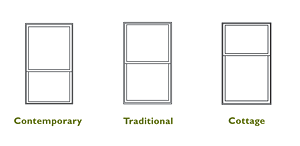Fiberglass Fenestration: A Durable, Sustainable, and Economic Alternative for Windows and Doors
Fixed frames, unlike fixed windows, do not have a sash. They offer the design flexibility of fixed aluminum glazing systems, while providing significantly improved energy efficiency. Unlike aluminum systems that are glazed in the field, fixed frames are often glazed in a controlled factory environment, thus maximizing quality control, while reducing field installation time. Steel reinforcements may be used for longer spans and higher design pressures. A range of sightlines can be achieved, depending on how the glass is subdivided to meet the design intent.
As with other styles of windows, grilles-between-the-glass, also known as integral muntins, may be placed between the glass panes to provide the look of divided lights. Another way to subdivide the glass is through the use of applied muntins. Since they can match the frame in size and color, they can be used to provide the look of multiple windows or aluminum storefront. They are typically applied to both sides of the glass for a similar appearance on the inside and outside. The width of the applied muntin can be the same as the frame, to provide a clean, commercial look. The color typically matches the frame on both sides.
|
Grilles-between-the-glass, applied muntins, and integral mullions can be used in combination to simulate the appearance of various window types, such as transoms, double-hung, and awning style windows.
In addition, the same design elements can be used to create the look of storefronts and ribbon windows.
|
Sliding windows are generally available in two or three panel configurations, and various sizes. When combined with fixed windows, sliding windows can provide a range of design, ventilation and egress solutions, while meeting project budgets. Corrosion-resistant nylon rollers on each sash will ensure easy operation in all environmental conditions. In contrast, windows with brass rollers may corrode and rust over time.
|
|
Sliding doors are suitable for commercial and residential applications, such as multi-family, hospitality, and assisted living projects, to save space and create easy outdoor access. Durable locks will ensure security is not compromised. When the sliding panel is located on the exterior, higher winds will tighten the seal against air and water infiltration. Screens located on the interior are less prone to damage, easier to operate than those on the exterior, and will be protected from the elements. Hardware finishes and available options provide additional design opportunities to meet budget needs.













